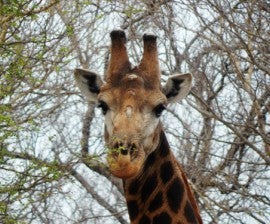-

Giraffes are gravely imperiled by habitat loss, hunting for meat, and the international trade in bone carvings and trophies. Adam Peyman/HSI
WASHINGTON—An American who allegedly hunted down a giraffe in South Africa in 2017 and posted her trophy on social media is making headlines all over again around the globe this week. Iris Ho, senior specialist, wildlife programs and policy for Humane Society International, issued the following statement:
“Trophy hunting of giraffe is a sheer display of arrogant disregard for the imperiled status of this iconic species. A 2015 estimate found that fewer than 100,000 giraffes remain in the wild in Africa, yet nearly 4,000 giraffe trophies were imported into the U.S. over the last decade—equal to more than one giraffe killed every day.
Speak out against trophy hunting.
“With the giraffe’s population decline at 40 percent over the last 30 years, they need all of the protection they can get. Giraffes are facing a myriad of threats including poaching and habitat fragmentation. Their dire conservation status should not be further compounded by the horror of trophy hunters bent on killing them for senseless and gruesome trophies.”
Background:
- Dubbed “the silent extinction,” the tallest land animal, the giraffe, is experiencing an alarming population decline with 40 percent of the population wiped out during the last three decades.
- In 2016, the International Union for the Conservation of Nature elevated the threat status of giraffes from “least concern” to “vulnerable” on its Red List of Threatened Species. Among the nine subspecies, two are assessed as “endangered.”
- The United States plays a major role in the giraffe trade, importing more than 20,000 bone carvings, 3,000 skin pieces and almost 4,000 hunting trophies from 2006 to 2015 (latest years for which data were available).
- Giraffes have no protection under U.S. law. In April 2017, the Humane Society of the United States, Humane Society International and conservation partner groups petitioned the U.S. Fish and Wildlife Service to list giraffes as “endangered” under the U.S. Endangered Species Act. An ESA listing would restrict the import, export and sale of giraffe specimens in the U.S.
- A 2017 economic analysis found that trophy hunting has relatively low economic value as a wildlife-related activity. While tourism contributes to at most 5.1 percent of the GDP among the eight African study countries, the total economic contribution of trophy hunting is at most about 0.03 percent of that figure. Foreign hunters make up less than 0.1 percent of tourists on average and they contribute 0.78 percent or less of the $17 billion in overall tourism spending. Trophy hunting’s contribution to tourism employment is only 0.76 percent or less of average direct tourism employment.
- Giraffes have a breeding life span of about 18 years, and bulls are sexually mature at 4-5 years but it is only at age 7 that they actually breed. Bulls could continue to reproduce even until their later years.
- New research recently revealed that giraffes live in complex societies, much like elephants, and have unique physiological traits, like the highest blood pressure of any land mammal.
Media Contact: Rodi Rosensweig, 203-270-8929, RRosensweig@humanesociety.org
